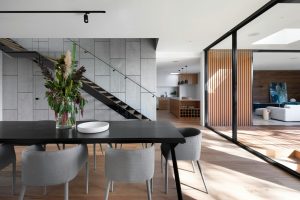Infinite Adaptability: Residential Designs for Unpredictable Future Scenarios
The world is constantly changing, and as we face ever-evolving challenges such as climate change and global pandemics, the need for adaptable solutions becomes increasingly apparent. This is especially true for residential design, as our homes serve as our sanctuary and our first line of defense against any unforeseen circumstances. As such, the concept of infinite adaptability has become a key consideration in the design and construction of modern homes. In this article, we will explore the importance of incorporating infinite adaptability in residential designs to prepare for unpredictable future scenarios.
What is Infinite Adaptability?
Infinite adaptability refers to the ability of a structure to easily and effectively adjust to changing conditions, without the need for major renovations or rebuilding. It involves the use of resilient materials, flexible layouts, and modular designs that can be modified to suit different purposes and accommodate various needs.
Resilient Materials
One of the essential components of infinite adaptability is the use of resilient materials in construction. These materials are able to withstand a wide range of challenges, from extreme weather events to natural disasters. For example, using reinforced concrete for foundations and walls can increase a building’s structural strength and durability, making it more resilient to earthquakes or intense storms.
Moreover, the use of environmentally friendly and sustainable materials can further enhance the adaptability of a home. These materials are often more durable and energy-efficient, making them a better long-term investment. They also contribute to a healthier living environment, which is crucial in preparing for unpredictable future scenarios.
Flexible Layouts
In addition to materials, the layout of a home also plays a crucial role in its adaptability. Designing with flexibility in mind involves creating spaces that can easily be repurposed or reconfigured as needed. For example, open-concept living areas can be partitioned to create smaller rooms, or rooms can be combined to create a larger space for multi-purpose use.
Moreover, incorporating universal design principles, such as wider hallways and doorways, level entrances, and lever-style door handles, can make a home more accessible for people with different physical abilities. This not only increases a home’s adaptability but also allows people to age in place comfortably.
Modular Designs
Modular designs involve creating homes from prefabricated or pre-built modules that can be easily assembled and disassembled, allowing for quick and efficient changes to the structure. This approach not only increases a home’s adaptability but also reduces construction waste and minimizes the time and labor required to build a home.
Furthermore, modular designs offer the flexibility to add or remove modules as needed, making them ideal for a future scenario where additional living space may be required due to unforeseen circumstances, such as unexpected guests or an unplanned home office.
Why is Infinite Adaptability Important?
Infinite adaptability is essential for preparing for unpredictable future scenarios. With the increasing frequency of extreme weather events, rising sea levels, and other unexpected challenges, having a home that is able to withstand and adapt to changing conditions is crucial.
Furthermore, the COVID-19 pandemic has highlighted the importance of having a flexible living space that can accommodate the changing needs of the household. With more people working from home, an adaptable home can provide the necessary space for a home office or a dedicated homeschooling area for children.
In Conclusion
Incorporating the concept of infinite adaptability in residential design is crucial for preparing for unpredictable future scenarios. By using resilient materials, flexible layouts, and modular designs, a home can easily adjust to changing conditions, providing a safe and comfortable living space for its occupants. As the world continues to evolve, it is essential to embrace the idea of infinite adaptability to create homes that can stand the test of time.










